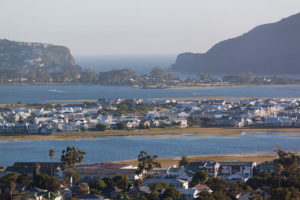See our best Knysna Lagoon Accommodation
History Of Knysna

The lagoon meets the ocean at “The Heads”
The town was founded in 1804 by George Rex, allegedly a son of King George III of England and Hannah Lightfoot, a member of the Quaker movement. The town originated on Rex’s farm Melkhoutkraal. He lays the foundation for the local timber industry and builds a seaport.
The NG congregation was founded in 1851. The famous Belvidere church was built on the other side of the lagoon in 1855.
Gold was discovered at Millwood in 1876 but the rush was short-lived.
The town became a municipality in 1881. On 7 June 2017, a forest fire broke out which resulted in major damage.
Local
Municipality – The municipality registered a coat of arms with the Cape Provincial Administration in 1960: Quarterly, I in gold a white horse’s cut off the head of natural color; II in blue a diagonally placed silver fern; III in blue a yellowwood tree of gold; IV in gold a distinguished elephant head of natural color. The crest was a sailing ship and the motto “Concilio et prudential”. Ivan Mitford-Barberton designed the weapon.
Divisional Council – Knysna’s Divisional Council (ie the local authority for the rural areas outside the town limits) registered a coat of arms with the Provincial Administration in 1961: Slanted cross, I in gold a stinkwood tree on a grassy ground all of the natural color; II and III in silver three wavy blue crossbeams; IV in green the ship Knysna of natural color, the sails laden with two climbing red lions and with blue fluttering pennants. Schalk Pienaar designed the weapon.
Khayalethu South – The town’s village committee registered a coat of arms with the Bureau of Heraldry in 1990: Pine-shaped cross-section, silver and green, on the point of honor a black block; A karoo gable-shaped knobby blue shield head. The crest was a green wall crown, and the motto was “Wisdom – Freedom – Democracy”.
Nature

Lagoon and beaches
The lagoon is rich in marine life – including shrimp, crabs, and other crustaceans. The Knysna River empties into the lagoon. There are two natural islands in the lagoon Thesen Island and Leisure Island. Thesen Island was first called Horse Island but became known as Thesen Island when the Thesen family took over the island and operated a sawmill there. Both islands are connected to the country after roads were built for them. Leisure Island is a prestigious residential area. Thesen Island was also developed and has also become a prestigious residential area.
The National Knysna Lake area was proclaimed in 1985 and under the control of the National Parks Board placed. The protected area covers approximately 15 000 ha. This was done to achieve a balance between the development and conservation of natural resources.
There are also several beaches in the area. The lagoon joins the sea between two cliffs called “Die Koppe” and forms a beautiful natural beauty. The nearest beach is at Brenton-on-Sea while Buffalo Bay beach is also very famous.
Native animals
The Knysna seahorse is native here and is protected. The forests near Knysna have long been inhabited by a native Knysna elephant herd and by the Knysna Lorie, a small parrot-like bird.
Activities
Oyster Nursery
The well-known Knysna Oyster is found in the Knysna Lagoon, but the oysters grown for human consumption are a Pacific species, Crassostrea Gigas. This species reaches maturity in just six months while the native oysters (Striostrea margaritacea), also known as the Cape oyster, take up to three years to reach maturity. There is about 6 ha of oyster beds in the lagoon.
During the first week of July, the annual Oyster Festival takes place. The South African Navy usually also takes part in the proceedings, and frigates anchor at the town’s local port. The forest marathon, road bike and mountain bike races also form part of the festival.
Fishing
The lagoon is home to nearly 200 fish species; here fishing is extremely popular among South African anglers. Known species caught are cod, blunt-nosed owl, white-breasted grebe, and grumpy rooster; while galleon can be caught from the beaches and rocks. Giant mud crabs and bloodworms occur in some areas, while mud shrimp occur in virtually the entire lagoon.
Timber Industry
Knysna is today a center for wood processing with furniture and boats as the main products. Knysna is surrounded by natural indigenous forests, known as the Knysna Forest. The Thesen and Parkes families played a major role in the development of the lumber industry after both families built sawmills; Thesen’s on Horse Island and Parkes in town. After Parkes moved their sawmill, the area was developed into Woodmill Lane, a shopping mall. There is currently 30,000 ha of pine and eucalyptus plantations in the district.
Sports
The town has three golf courses and several sports clubs e.g. rugby, roadrunners, and a canoe club. The annual Karoo-to-Coast Mountain Bike Race also ends in Knysna during September.
The National Sea Rescue Institute of South Africa also operates a station in Knysna.
